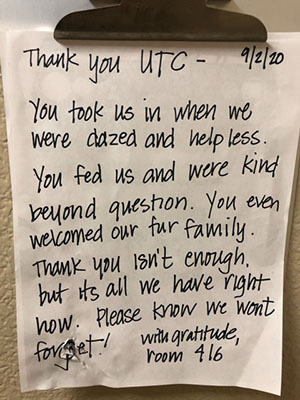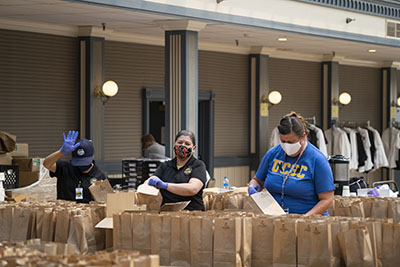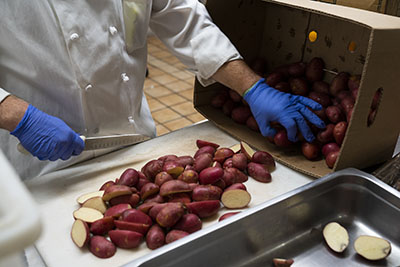Threatened with wildfires in August and September, an army of UC Santa Cruz employees worked hard to keep their community safe, fed, and housed.
Their fast and focused response speaks to the dedication of these workers, and their strong sense of personal and professional responsibility, said Sarah Latham, vice chancellor of business administrative services, who helped oversee the campus’s fire response.
“It was really heartening—the stories of people helping each other in this horrible situation,” Latham said. “It showed the best of who we are as a campus, as a community, as people coming together to support each other, especially considering the fact that the people who were helping were also being impacted.”
Those employees helped to secure the UC Santa Cruz campus and relocate the 1,215 people who were living on the campus, or nearby, when the fire broke out.
The CZU August Lightning Complex Fires started on the early morning of August 16, when a thunderstorm rained more than 11,000 lightning bolts, setting off hundreds of wildfires. By the time the fire was 100 percent contained on Tuesday, September 22, the blazes had consumed more than 86,509 acres and destroyed 925 homes, killing one person and injuring another.
It was a time of uncertainty and stress for many community members—including the UC Santa Cruz employees who were working hard to help others while facing dislocation themselves. An estimated 600 UC Santa Cruz staffers had to evacuate from their homes in Davenport, Felton, Bonny Doon, and on campus, Latham said.
“I would be on Zoom calls, and someone would have to drop off the call because they had to evacuate, or they could see the fires in the distance,” Latham said.
UC Santa Cruz’s Director of Dining Bill Prime, whose team arranged to move food services down to the evacuation center set up at the Cocoanut Grove Ballroom at the Santa Cruz Beach Boardwalk, was on one of those frightening Zoom calls.
On Prime’s screen, other Zoom participants could see the fire in the distance.
“He showed us a view of the mountain in the distance and said, ‘Now we have to go,’’’ Latham said.
The impact on the UC Santa Cruz community was far-ranging. About 40 university employees lost their homes in the fires.
“Their homes were either destroyed, or damaged to the extent that they were not inhabitable,” Latham said.
Some evacuees relocated with loved ones, while others were taken to the University Town Center in Santa Cruz or to various Santa Cruz hotels, including the Carousel Beach Inn and the Sea and Sand Inn. One campus employee, shortly before leaving the UTC, left a heartfelt note of appreciation: "You took us in when we were dazed and helpless. You fed us and were kind beyond question."
The note-writer also thanked the staff for being kind to the family's pets, described as their "fur family. Thank you isn't enough but it's all we have right now. Please know we won't forget!"
A few evacuees stayed overnight at the Cocoanut Grove at the Santa Cruz Beach Boardwalk, which was used as a relocation center for UC Santa Cruz. About 40 students were moved to residence halls at San Jose State University, which threw open its doors for students in need.
Adjusting quickly to a dangerous situation
Not long after the fire broke out, the Santa Cruz County government was considering UC Santa Cruz as an evacuation center for impacted communities. But that plan was scrapped when it became clear that the heavily wooded, 2,000-acre campus was in the fire’s path.
As it turned out, the fire never breached the campus. As a precautionary measure to protect UC Santa Cruz and the city of Santa Cruz, the California Department of Forestry and Fire Protection dug fire breaks on the edge of campus to stop the spread of wildfire.
The campus’s coordinated response was swift and efficient, Latham said.
“Things went very well and we were able to evacuate the campus relatively quickly because we started communications early, and people heeded the message,” she said.
By the time Cal Fire issued its formal evacuation order for the campus on the Sunday after the fire broke out, “most everyone was already gone from the campus,” Latham said.
The fire added another layer of complexity to the campus's response to the COVID-19 crisis.
“We needed to set up safety precautions with PPE and physical distancing when we set up the evacuation center and when we were transporting people on buses over the hill,” she said.
But she also spoke of the "reverse impact." The fire response and evacuation delayed a planned COVID-19 testing ramp-up at UC Santa Cruz.
“So there was an intersection, where one crisis impacted another crisis,” Latham said
A helping hand
While the fire was unpredictable, the UC Santa Cruz community’s outpouring of support was strong and consistent. UC Santa's University Relations office established the UC Santa Cruz Wildfire Relief fund, and started raising money while the fire was still raging.
That fundraising effort was later folded into Giving Day, a 24-hour online giving festival. More than 1,000 donors stepped forward to raise nearly $153,000 for the fire relief fund.
As of this writing, 72 campus employees have received more than $73,000 to help them pay for food, shelter, clothing, rent payments, out-of-pocket medical expenses, and assistance with repairs for damaged homes.
These grants are intended to help employees with expenses that will not otherwise be reimbursed or covered by insurance. Additionally, funds raised for the Slug Support Fund are going directly to students who have been impacted by the wildfire.
Those funds will help the UC Santa Cruz community in the aftermath of the fire. But “getting back to normal’’ is a long and complicated process.
Even the act of resettling displaced campus residents was nuanced and painstaking. When the fires broke out, workers had to “harden” the campus, turning off electricity and gas to minimize the potential for explosions if the fire engulfed the campus. It took two weeks to undo all those necessary protections.
“People were working around the clock including weekends to bring systems back online, to transfer utilities back over,” Latham said.
For every campus building that reopened, the fire marshal, Physical Plant staff, and Environmental Health and Safety all had to give the go-ahead, with Latham and Associate Vice Chancellor of Risk and Safety Services Jean Marie Scott doing the final sign-offs. Administration also had to wait for the smoky air to clear.
“It’s a step-by-step process,” Latham said. “You can’t just bring people back.”
Like every step of the fire response, the resettling of the campus required a combination of planning and flexibility, Latham said.
“We’ve never had a full-campus evacuation before. We responded in phases—response, recovery, and resiliency," she said. "Resilience means learning through experience. Hopefully, this will never happen again. But if it does, we will be well prepared.”






